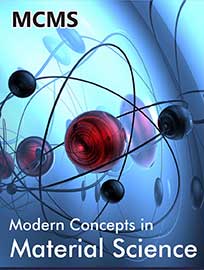 Research Article
Research Article
Impact of Defects on the Mechanical Performance of Boron Nitride Nanotubes (BNNT)
Nachiket S Makh1 and Ajit D Kelkar2*
1Department of Nanoengineering, North Carolina A&T State University, USA.
2Department of Mechanical Engineering, North Carolina A&T State University, USA.
Dr. Ajit D. Kelkar, Department of Mechanical Engineering, North Carolina A&T State University, 1601 E Market St, Greensboro, NC 27411, USA
Received Date: May 20, 2024; Published Date: June 13, 2024
Abstract
High-energy radiation hazards are a major concern for space missions. Considerable efforts are being made to develop efficient, lightweight, cost-effective multifunctional radiation shielding materials for providing structural integrity and damage tolerance. One of the leading materials being explored is the use of Boron Nitride Nanotubes (BNNT) in conjunction with fiber-reinforced material that can not only provide radiation shielding but also help to improve the mechanical strength of aerospace structures. Radiation shielding is one of the important applications of BNNT owing to its good mechanical properties. These properties get compromised if the BNNTs are having vacancies mostly known as point defects. This study presents the effect of defects on the mechanical properties of BNNTs using molecular dynamics (MD) simulations. The study would help to understand the effects of defects in BNNTs when dispersed in polymer matrix composites for radiation shielding applications.
Keywords: Space radiation; Nanoscale; BNNT; Defects; MD; LAMMPS; VMD
Introduction
The Sun constantly emits radiation that provides the required warmth and visible light necessary for the sustainability of life on Earth. This radiation is a mixture of ultraviolet light, X-rays, radio waves, infrared waves, and gamma rays. Sometimes, the Sun emits exceedingly large, highly energized particles that can be harmful to Earth’s ecosystem. The magnetosphere is a region that surrounds a planet, generated from its own internal magnetism. Earth’s magnetosphere envelops the planet with a system of magnetic fields, shielding it from harmful cosmic and solar particle radiation, as well as atmospheric erosion by the solar wind. Outside Earth’s magnetosphere, exposure to these highly energized particle radiations is inevitable, making space programs [1,2] vulnerable to these emissions.
Apart from solar particle events (SPE), galactic cosmic rays (GCR) are also present in space. GCRs are high-speed nuclei that are accelerated by the magnetic fields of supernova residues. They are massive, high-energy ions of elements whose electrons are stripped away as they travel through the Milky Way at the speed of light. While traveling through space, they can ionize the surrounding atoms and can pass unaltered through the skin of an astronaut or the spacecraft material [3,4]. These rays may cause serious biological damage and can result in damage to the structural materials and electronic components of the spacecraft. Studies have shown that exposure to these radiations can cause adverse health effects [5,6], including cataract formation, genetic mutation, and cancer.
The safety of astronauts and spacecraft from the radiation environment outside the magnetosphere has been a particularly
challenging objective [7]. Conventional radiation shielding materials are heavy and bulky, exhibiting limited effectiveness in blocking the emission of secondary neutrons [8,9]. Research [10,11] has revealed advancements in the development of engineered nanomaterials designed for integration into spacecraft components, spacecraft electronics, and space suits to achieve radiation shielding. Elements with low atomic numbers, such as hydrogen [11], are considered the best choice for radiation shielding. Low-atomicnumber elements have fewer protons in their nuclei, resulting in less interaction with other protons and heavier ions, providing a better chance for charged particles to be absorbed by losing their energy, thus reducing penetration depth. Additionally, in radiation physics, boron (B) is prominently known for its radiation-shielding properties against charged particles and neutrons. Therefore, for space applications, the use of boron [12,13] to minimize harmful neutron radiation is crucial.
Boron Nitride Nanotube (BNNT)
After the discovery of carbon nanotubes (CNTs) in 1994, a hypothesis about the existence of boron nitride nanotubes (BNNTs) was presented, and in 1995, they were first synthesized using the arc discharge method [14,15]. Other synthesis methods include chemical vapor deposition (CVD) and laser ablation [16]. Similar to carbon nanotubes (CNTs), boron nitride nanotubes have carbon atoms completely replaced by an equal number of boron and nitrogen atoms, forming a B-N bond. Figure 1 shows the structural similarity between CNTs and BNNTs. Different crystalline structures of boron nitride include cubic BN (c-BN), wurtzite BN (w-BN), rhombohedral BN (r-BN), and hexagonal BN (h-BN). H-BN has been examined in the past for radiation shielding [12] purposes.
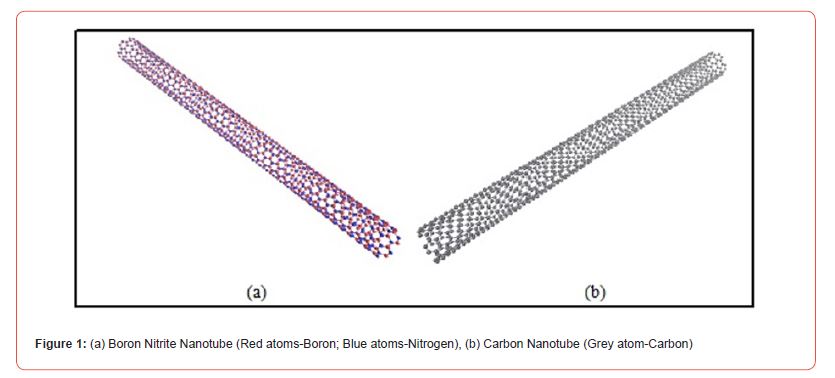
Different layers of h-BN in BNNTs are bound together by van der Waals forces of attraction. BNNTs exist in single-walled and multi-walled forms. Depending on the chirality, the nanotubes can be either armchair or zigzag, determined by the chirality vector given in equation (1).
ch = na1 + ma2[14] (1)
The components a1, a2 are the unit vector and (n, m) are the chiral indices of the graphite sheet. If m=0, then Ch = na1 defines a zig-zag nanotube while m=n defines armchair nanotube.
The mechanical properties and thermal conductivity of BNNTs and CNTs are closely comparable [17]. Due to its high specific surface area (SSA), chemical inertness, and oxidation resistance, BNNT is a very suitable candidate for hydrogen storage applications [18,19]. Because of these excellent properties, BNNTs can be used as structural elements to provide mechanical strength and radiation shielding in Extravehicular Mobility Unit (EMU) and spacecraft for space exploration [20,21].
Defects or impurities present in the nanotubes affect their mechanical properties. Sometimes, twisting could also introduce defects and deformations that affect the stability of the nanotube. Under torsion, the twisted and non-twisted regions show different mechanical responses. Torsion [22] can cause changes in the density of states and electronic band structure, impacting the electrical behavior and thus modifying the electrical conductivity of the nanotube. This paper presents a comparison of the mechanical properties of boron nitride nanotube (BNNT) with and without defects using the Molecular Dynamics (MD) simulation technique. For simulation, the Large-scale Atomic/Molecular Massively Parallel Simulator (LAMMPS) [23] software was used, and for visualization, Visual Molecular Dynamics (VMD) [24] was employed.
Modelling
The BNNTs were developed using the nomenclature referred to in [14]. With the assistance of VMD, we modeled four zig-zag (4,0), (8,0), (12,0), and (16,0) nanotubes, as well as four armchair (4,4), (8,8), (12,12), and (16,16) nanotubes, each with a length of 100 Å using the nanotube modeler. The Cartesian coordinates were then saved as LAMMPS executable files. The number of Boron and Nitrogen atoms in the nanotubes ranges from 350 to 2600 atoms. Subsequently, MD simulations were performed in the LAMMPS software using the Tersoff [25] interatomic potential for B-N interaction. To prevent interaction between B-N atoms across the boundary, non-periodic and shrink-wrapped boundary conditions were employed. The bond length used for constructing the nanotube was 1.44 Å.
The BNNT structures underwent minimization using the conjugate-gradient method. Minimization was carried out within the canonical (NVT) ensemble at 300 K. The Velocity-Verlet algorithm was employed to integrate Newton’s equations of motion at a timestep of 1 fs. Tensile loading was applied to the BNNT by fixing both ends and pulling them outwards until failure occurred. Intentional introduction of defects in the nanotube was performed by removing atoms using VMD software. Figure 2 displays defective and non-defective BNNTs under tensile loading.
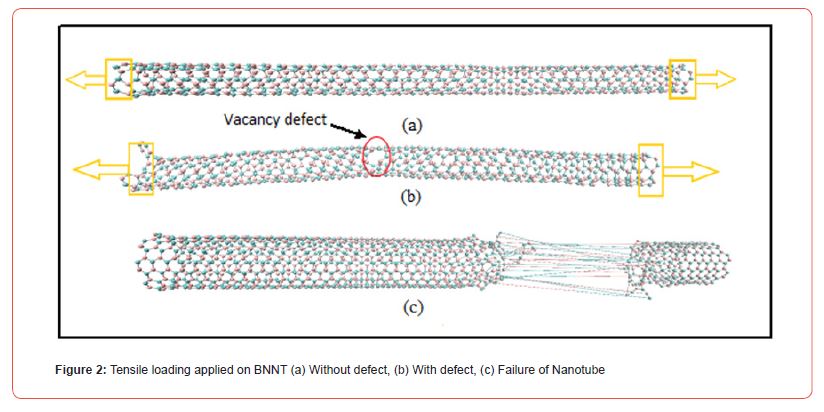
Results and Discussion
The mechanical properties of both armchair and zigzag BNNTs with different chirality were predicted, and the stress-strain results were plotted in MATLAB, as shown in Figure 3 (a) and (b). Young’s Modulus was calculated by considering only the elastic region of the stress-strain curve.
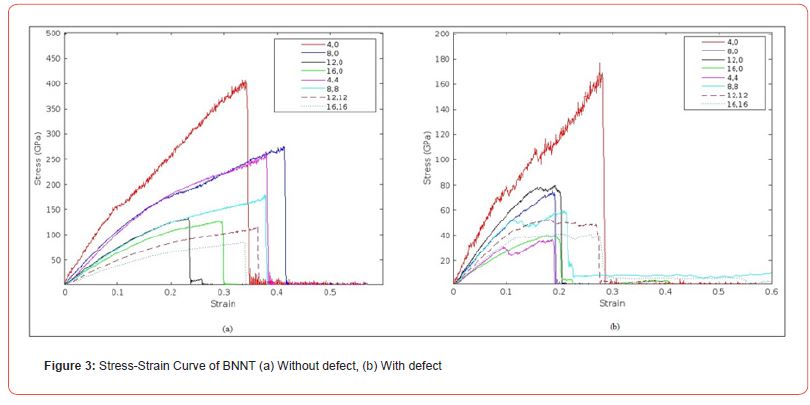
Deficiency of boron or nitrogen atoms in the crystal lattice of BNNT creates vacancy defects. It is observed that, with increasing vacancies, the strength reduces. For both armchair and zig-zag nanotubes, a maximum vacancy concentration of 2% was incorporated to determine the mechanical strength. These vacancies function as regions of stress concentration, serving as starting points for crack propagation that leads to the mechanical failure of the nanotube. Additionally, these vacancies can create localized states within the band gap of BNNTs, trapping charge carriers and affecting the optical absorption and emission peaks in the optical spectrum. The nature of these peaks depends on the type and concentration of the vacancy defect. It has been found that vacancies can significantly change the bandgaps [22], which can, in turn, affect the optical properties.
From the stress-strain curve, it can be observed that stress and strain increase linearly until a certain point for both defective and non-defective BNNTs. This region is known as the proportionality limit. After this point, the increase in strain is more pronounced with a minor increase in stress, marking the yielding region. In this region, the nanotube is unable to withstand more strain, reaching a point where it can no longer deform. The nanotube absorbs more stress and continues to deform until it fails. This deformation occurs under a strain rate of 0.0014 fs-1.
From Figure 3(a) and (b), it can also be seen that the peak value of the stress-strain curve for BNNTs with defects is lower than that for those without defects. This indicates that B-N nanotubes with vacancy defects have less strength and toughness. In the present study, the ultimate stress-strain and Young’s Modulus for both nondefective and defective BNNTs are reported in Table 1. The values predicted for non-defective BNNTs are in good agreement with past studies [3,12,26].
Table 1: Ultimate Stress-Strain and Young’s Modulus of BNNT with different chirality
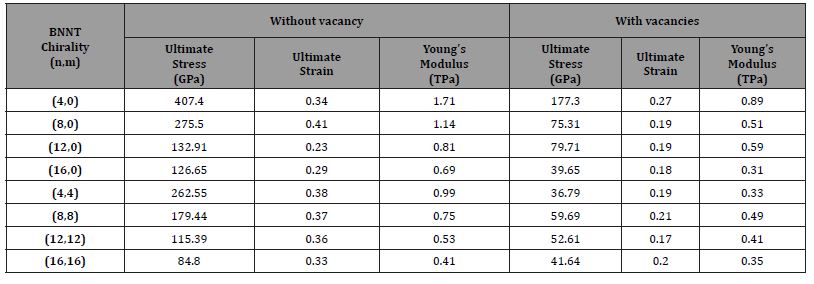
Studies show that defective BNNTs could enhance the entrapment of hydrogen, thereby aiding in the production of BNNTs with hydrogen storage applications [26,27]. The Young’s Modulus obtained for defective BNNTs is also in accordance with previous studies [28,29]. The models used in these studies are different and are self-explanatory, contributing to the inconsistent values of Young’s Modulus.
Conclusion
This study investigates the effects of defects on the mechanical properties of boron nitride nanotubes (BNNTs). The properties are predicted for both armchair and zig-zag types of single-walled BN nanotubes. MD simulations were conducted using LAMMPS software, and visualization was performed using VMD Software. The Young’s Modulus of defective BNNTs is found to be lower than that of non-defective BNNTs, indicating a reduction in stiffness and strength due to point defects. The predicted properties align well with previous research studies. The present study only addresses the effect of defects on the mechanical properties of BNNTs under tensile loading. Further evaluation is needed to understand the impact of vacancy defects on BNNTs under torsion, shear, and biaxial loading.
Acknowledgement
This work was performed in whole/part at the Joint School of Nanoscience and Nanoengineering, a member of the National Nanotechnology Coordinated Infrastructure (NNCI), which is supported by the National Science Foundation (Grant ECCS- 2025462).
Conflict of Interest
Not Applicable.
References
- National Aeronautics and Space Administration (2021) Earth’s Magnetosphere (K. Fox, Ed.)
- Hu S (2017) Solar Particle Events and Radiation Exposure in Space. National Aeronautics and Space Administration.
- Singh K (2021) Review of Boron Nitride Nanotubes for Space Radiation Shielding (Doctoral dissertation, Georgia Institute of Technology).
- National Aeronautics and Space Administration (2019) Why Space Radiation Matters (J. Perez, Ed.)
- National Council on Radiation Protection and Measurements (NCRP) (2006) Information Needed to Make Radiation Protection Recommendations for Space Missions Beyond Low-Earth Orbit; NCRP: Bethesda, MD, USA.
- Chancellor JC, Scott GB, Sutton JP (2014) Space radiation: the number one risk to astronaut health beyond low earth orbit. Life 4(3): 491-510.
- Letaw JR, Silberberg R, Tsao CH (1989) Radiation hazards on space missions outside the magnetosphere. Advances in Space Research 9(10): 285-291.
- Cao D, Yang G, Bourham M, Moneghan D (2020) Gamma radiation shielding properties of poly (methyl methacrylate)/Bi2O3 Nuclear Engineering and Technology 52(11): 2613-2619.
- Blachowicz T, Ehrmann A (2021) Shielding of cosmic radiation by fibrous materials. Fibers 9(10): 60.
- Arepalli S, Moloney P (2015) Engineered nanomaterials in aerospace. MRS Bulletin 40(10): 804-11.
- Thibeault SA, Kang JH, Sauti G, Park C, Fay CC, et al (2015) Nanomaterials for radiation shielding. Mrs Bulletin 40(10): 836-41.
- Cheraghi E, Chen S, Yeow JT (2021) Boron nitride-based nanomaterials for radiation shielding: a review. IEEE Nanotechnology Magazine 15(3): 8-17.
- National Aeronautics and Space Administration (2019) Radiation Shielding Materials Containing Hydrogen, Boron, and Nitrogen: Systematic Computational and Experimental Study (L. Hall, Ed.)
- Rubio A, Corkill JL, Cohen ML (1994) Theory of graphitic boron nitride nanotubes. Physical Review B 49(7): 5081.
- Chopra NG, Luyken RJ, Cherrey K, Crespi VH, Cohen ML, et al. (1995) Boron nitride nanotubes. science. 269(5226): 966-7.
- Kim JH, Pham TV, Hwang JH, Kim CS, Kim MJ, et al. (2018) Boron nitride nanotubes: synthesis and applications. Nano convergence 5(1): 1-3.
- Jiang XF, Weng Q, Wang XB, Li X, Zhang J, et al. (2015) Recent progress on fabrications and applications of boron nitride nanomaterials: a review. Journal of Materials Science & Technology 31(6): 589-598.
- Li J, Lin J, Xu X, Zhang X, Xue Y, et al. (2023) Porous boron nitride with a high surface area: hydrogen storage and water treatment. Nanotechnology 24(15): 155603.
- Ghazizadeh M, Estevez JE, Kelkar AD (2015) Boron nitride nanotubes for space radiation shielding. Int. J. Nano Stud. Technol 4: 1-2.
- Chen Y, Zou J, Campbell SJ, Le Caer G (2004) Boron nitride nanotubes: Pronounced resistance to oxidation. Applied physics letters 84(13): 2430-2.
- Golberg D, Bando Y, Tang CC, Zhi CY (2007) Boron nitride nanotubes. Advanced Materials. 19(18): 2413-32.
- Choyal V, Choyal VK, Kundalwal SI (2019) Effect of atom vacancies on elastic and electronic properties of transversely isotropic boron nitride nanotubes: a comprehensive computational study. Computational Materials Science 156: 332-345.
- Plimpton S (1995) Fast parallel algorithms for short-range molecular dynamics. Journal of computational physics 117(1): 1-9.
- Humphrey W, Dalke A, Schulten K (1996) VMD: visual molecular dynamics. Journal of molecular graphics 14(1): 33-38.
- Kınaci A, Haskins JB, Sevik C, Çağın T (2012) Thermal conductivity of BN-C nanostructures. Physical Review B 86(11): 115410.
- Estevez J (2014) Fundamental Properties of Thermoset Resin with Boron Nitride Nanotube Reinforcement for Radiation Shielding Applications (Doctoral dissertation, University of North Carolina at Greensboro).
- Matarín O, Rimola A (2016) Influence of defects in boron nitride nanotubes in the adsorption of molecules. Insights from B3LYP-D2* periodic simulations. Crystals 6(5): 63.
- Wang H, Ding N, Zhao X, Wu CM (2018) Defective boron nitride nanotubes: mechanical properties, electronic structures and failure behaviors. Journal of Physics D: Applied Physics 51(12): 125303.
- Darwish AA, Hassan MH, Abou Mandour MA, Maarouf AA (2019) Mechanical properties of defective double-walled boron nitride nanotubes for radiation shielding applications: a computational study. Computational Materials Science 156: 142-147.
-
Nachiket S Makh and Ajit D Kelkar*. Impact of Defects on the Mechanical Performance of Boron Nitride Nanotubes (BNNT). Mod Concept Material Sci. 6(2): 2024. MCMS. MS.ID.000633.
-
Space radiation, Nanoscale, BNNT, Defects, MD, LAMMPS, VMD, Molecular dynamics, Aerospace structures, Magnetosphere, Hydrogen
-

This work is licensed under a Creative Commons Attribution-NonCommercial 4.0 International License.



